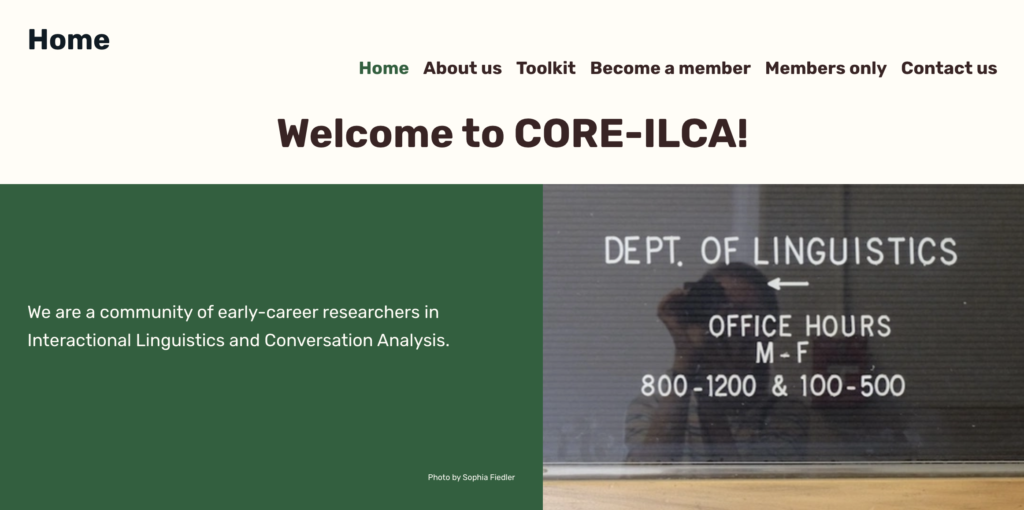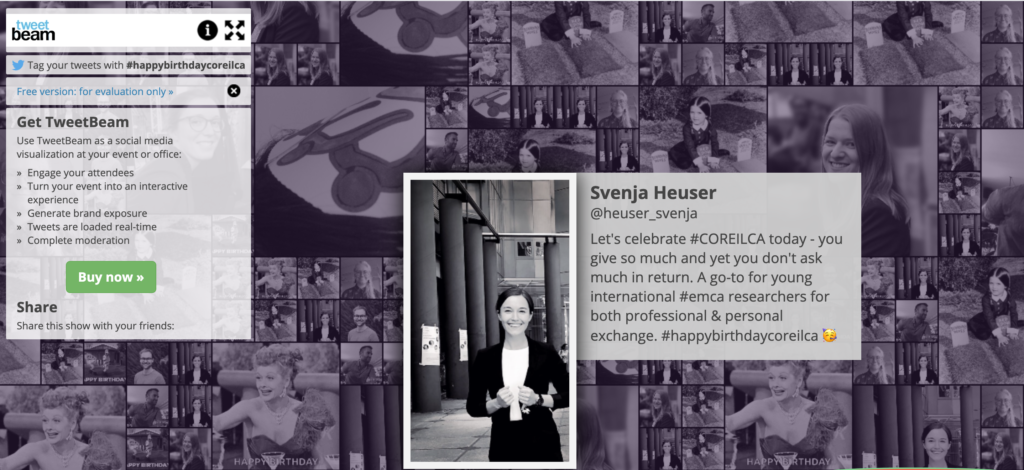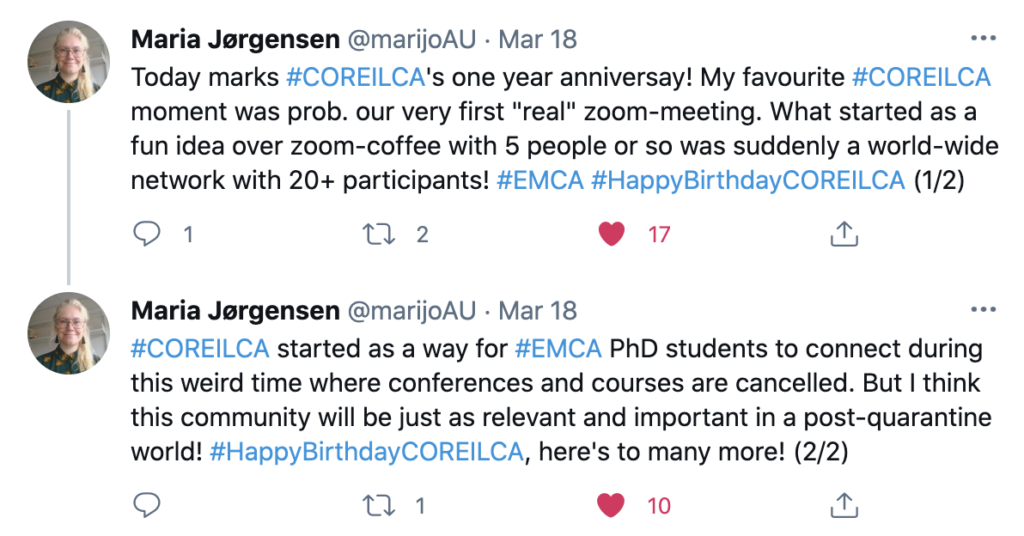By Virginia Calabria†, PhD candidate at KU Leuven and University of Neuchâtel & Sophia Fiedler†, PhD candidate at University of Neuchâtel and University of Hamburg
1. Introduction: Why that now?
This paper analyzes CORE-ILCA (virtual community of early career researchers – ECRs – in Interactional Linguistics, Ethnomethodology & Conversation Analysis – ILEMCA) as a social phenomenon. On an international level, ECRs often do not have many opportunities to interact except for large conferences. These are often expensive and not easily attainable for everyone, let alone on a regular basis. In times of Covid-19, networking has become even harder and many ECRs lack intellectual exchange and social contact with their peers.
To answer the famous analytical question “Why that now?” (Sacks, Schegloff & Jefferson 1974): our phenomenon, CORE-ILCA, which has emerged only recently, allows ECRs to connect, work together, share and multiply knowledge, create a mutual support network and strengthen collaborations and friendships between ECRs around the globe. In the words of CORE-ILCA: “/prəˈɡres/ together while being constantly in /’prəʊɡres/”.
The idea of building a community sprouted after a joint online gathering in March 2020, when the pandemic led to an almost Europe-wide lockdown with universities and libraries shut down. After a few weeks, a first group of ECRs built an exchange platform, held a first meeting, and agreed an organizational structure to move forward.
In this article, we want to show that CORE-ILCA is a social phenomenon that is interactionally organized. We will start from its emergence and evolution throughout 2020 (§2), then present the participants and our methodology (§3), describe CORE-ILCA’s organizational structure and principles (§4), and finally conclude with an outlook on further activity desiderata of the community (§5).
2. Background
In the era of global pandemics, when a new lexicon and set of practices are being established and routinized in our everyday life (“zoom-fatigue”, “smart working”, “virtual community”, etc.), it is not easy to find a balance between feeling isolated after 8h of screen-work at home, and spending yet 2 more hours in front of this same screen in order to feel less isolated. Previous empirical research (Goodwin 2007) has shown that participants systematically display their stance in conversation (frustration, anxiety, disagreement) in practices of collective remembering, co-constructed tellings, complaints, etc. In such choral activities, participants’ stories about conferences, overseas research stays, or a social night during a Graduate School invite co-participants to affiliate and to share second stories. In spring 2020, a group of ECRs from different countries (Calabria, Jørgensen, Mikkelsen, Satti & Sørensen 2020) interested in the sequentiality of frustration-in-interaction, noticed the emergence of another practice alongside affiliation: disaffiliation from the complaint story and projection of propositions and suggestions. In order to investigate further these sequences, they decided to collect more data: “[w]e came up with the idea of creating a virtual network of researchers […] who have started […] in this weird and complicated time […]. Taking the best out of these unlucky moments and using technology to talk to people we do not normally have the time to reach out to are the basic ideas!” (Calabria et al. 2020).
From the initial embryonic setting up of the network and building the corpus, CORE-ILCA has evolved and acquired a name and a logo (Fig. 1), a website and many more members. In the next sections of this paper we will follow the evolution of this phenomenon and investigate it as a situated interactional achievement.
3. Methodology and Data
For all practical purposes, Aldrup, Cantarutti & Fiedler built a website, https://coreilca.wordpress.com/ (Fig. 2), where the community’s organizational structure is made available to potential ratified participants-to-be. The latter have to formally subscribe via a form in the become a member section of the website. There is no member’s fee and the only condition members need to fulfill is to show interest in the disciplines of ILEMCA. Institutional affiliation is not necessary.

CORE-ILCA comprises, as of 1 April 2021, 146 members, from more than 40 countries, from masters’ students to postdocs. All interactions take place in English. When two native speakers of the same language form an exclusive participation framework without any (virtual) bystanders (Goffman 1979), another language may replace the usual lingua franca.
Until now, we have 1 year, 2 weeks and 6 days of interaction between members. None of them were recorded but there are field notes from regular gatherings (§4.3). Members can choose their level of engagement in the activities: “Participation, however, is not mandatory: CORE-ILCA is an opportunity and a resource, not more work to do” (Calabria 2020). In the following, we show that the interactional organization of CORE-ILCA is observable through different social action formats. To do so, we resort to the methodology of Conversation Analysis (Sacks, Schegloff & Jefferson 1974) and Interactional Linguistics (Couper-Kuhlen & Selting 2018).
4. Analysis
4.1 Activity formation: a matter of collaboration
The first collaborative action achieved by the community was choosing a name. After a brainstorming, a poll was made. Participants engaged in a vivid turn- and e-mail exchange around some trouble-sources (Jefferson 1988): the potential opaqueness of an acronym versus a transparent name, or the potential inclusion of the membership-categorization term (Sacks 1996) young. The acronym that reached the highest degree of consensus was CORE-ILCA (COmmunity for REsearchers in IL/CA), because of its semiotic ambiguity.
This detailed explanation of the process is crucial, since it is representative of the modus operandi and the choral orientation of CORE-ILCA towards decision-making processes (Stevanovic 2013).
We observed a similar process concerning the logo: a collaboration between Marina Cantarutti, Virginia Calabria and Elisabeth Apicella resulted in Fig. 1, representing an open, colorful, inclusive community.
CORE-ILCA includes two main kinds of activities, also agreed upon by the members: regular and sporadic. Within the former, we can count a bimonthly general meeting, that the current member of the organizational committee, Yotam Ben-Moshe, tailored to the participants’ contingencies (to enable participation from all time zones). During these meetings, participants engage in a variety of activities: debates about articles or research topics, informings, assessing or complaining activities about practicalities of the academic world, or only ‘doing being a group member’. During one of the first regular meetings, three specific interest groups formed: L2 in interaction, non-lexical vocalizations and collaborative turns & practices. We observe that the formation of groups works incrementally: moving forward in time, more groups will probably emerge, thus being “the result of spontaneously creating new combinations of forms” (Hopper 2011: 32) which “are improvised in much the same way that a jazz performance is improvised: publicly and jointly” (ibid.).
In just this way, further regular activities emerged: writing sessions, a reading group, and a tech-talk. The writing sessions take place on BigBlueButton or Wonder where with a group of “accountability buddies”, the members spend some hours writing and doing breaks together, relaxing around some “laughables”. The regular reading group was prompted by Søren Sørensen and treated the chapters of Visual Linguistics with R (Rühlemann 2020) while deviating towards other relevant papers. A “paper of the month”-initiative should start soon.
Finally, Elisabeth Apicella and Sam Schirm organize a “monthly tools and technology hangout” on BigBlueButton where everybody can attend with questions or topics related to transcription tools, software, their ethical use and much more.
Observable sporadic activities are data sessions, discussions of methodological topics, skills sessions (seminars held by volunteers on their K+(++) topics, e.g. ELAN, etc.). Every new initiative made relevant by the members is welcomed and integrated into the interactional machinery of CORE-ILCA.
The 18 March 2021, CORE-ILCA celebrated the #happybirthdaycoreilca event: the first anniversary of CORE-ILCA, with an informal gathering on Wonder where members met, played games and laughed until their cheeks hurt (fig. 3, 4).


4.2 Order at all points
Looking at ongoing interactions between participants we could identify two organizational principles.
Two committees have formed: one to maintain and update the website; the other to organize meetings and activities. Participation in these committees is based on self-selection (Sacks, Schegloff & Jefferson 1974). If no next participant self-selects, the ongoing committee has the right to address a potential next member. However, if the selected next does not accept the job-allocation, s/he is free to decline the offer. When participation is successfully allocated to a next, his/her engagement will last for 3 months for the website committee and 6 for the organizational committee, to ensure the participation framework constantly changes and avoid participants’ overstrain due to excessive holding of the turn. Every member gets a possibility to actively engage in the shared decision-making process, to keep the organizational structure as horizontal as possible.
4.3 Actions and resources
In CORE-ILCA, informings play a crucial role to keep the interaction going. Participants have three ways to do informings. For ‘stable informings’, participants can contact the website-committee which then makes the informing either publicly available at the next information-relevant place or publishes it in the closed participation framework of the ‘members only section’. The public informings include tools and resources; the ‘exclusive’ informings can be group-internal gatherings, minutes, etc.
The second way to make informings is the CORE-ILCA calendar. Members can add events like reading groups to the calendar to do asynchronous informings. Due to data protection the calendar remains restricted to members.
The third way to do informings in CORE-ILCA is the Google group with an implemented mailing list. Any request, assessment, announcement etc. can be made available through this group, where all asynchronous social interaction takes place.
The website can also be used as a resource for the participants to showcase their own research: members can have a link to personal websites or social media associated with their name in the ‘about us’-section.
5. Conclusions and outlook
In this paper we have argued that CORE-ILCA is a social, interactionally organized phenomenon with collaborative sequential structures and a shared decision-making process overarching all ongoing activities. The emergence of the phenomenon can be related to the suggestion (and need) of recreating the missing networking possibilities, resulting from Covid-19. But the general need for a larger community of peers, of support and exchange has brought CORE-ILCA to a whole year of activities and growth (fig. 5).
In its future the community sees: a collaboration with ISCA for a ILEMCA WIKI glossary prompted by Christoph Hottiger, with concepts in English and translations into those languages available in the community; workshops on transcription tools, practices of transcription and data collection with invited experts; a global annual ILEMCA graduation party to celebrate all the newly-minted PhDs, and finally, one big in-person event where the members will at last be able to meet.
Paraphrasing Schegloff (1996: 5): “The community is constructed and is attended by its recipients for the action or actions it may be doing”.
The CORE-ILCA community hopes to keep on working together for many more birthdays, expanding the range of activities made relevant by all its participants and strengthening the collaborative network.

† Both authors contributed equally to the piece.
References
Aldrup, M., Cantarutti, M. N., & Fiedler, S., (2020). CORE-ILCA wordpress website: https://coreilca.wordpress.com/home/about/
Calabria, V. (ed.) (2020). Towards a virtual community for interactional and EMCA early-career researchers. Email thread.
Calabria, V., Jørgensen, M., Mikkelsen, N., Satti, I., & Sørensen, S. (2020). Let’s build a community. In Calabria, V. (ed.).
Couper-Kuhlen, E. & Selting, M. (2018). Interactional Linguistics: Studying Language in Social Interaction. Cambridge: CUP.
Goodwin, C. (2007). Participation, Stance and Affect in the Organization of Activities. Discourse & Society 18(1), 53–73.
Goffman, E. (1979). Footing. Semiotica 25: 1-29.
Hopper, P. (2011). Emergent grammar and temporality in interactional linguistics. In Auer, P., & Pfänder, S. (Eds.). Constructions: Emerging and emergent. Boston: De Gruyter, 22-44.
Rühlemann, C. (2020). Visual Linguistics with R: A practical introduction to quantitative Interactional Linguistics. Amsterdam-Philadelphia: John Benjamins.
Sacks, H., Schegloff, E. A. & Jefferson, G. (1974). A Simple Systematic for the Organisation of Turn Taking in Conversation. Language 50 (4): 696-735.
Schegloff, E. A. (1996). Confirming allusions: Toward an empirical account of action. American Journal of Sociology 102 (1): 161-216 .
Stevanovic, M. (2013). Constructing a proposal as a thought: A way to manage problems in the initiation of joint decision-making in Finnish workplace interaction. Pragmatics 23(3): 519-544.

